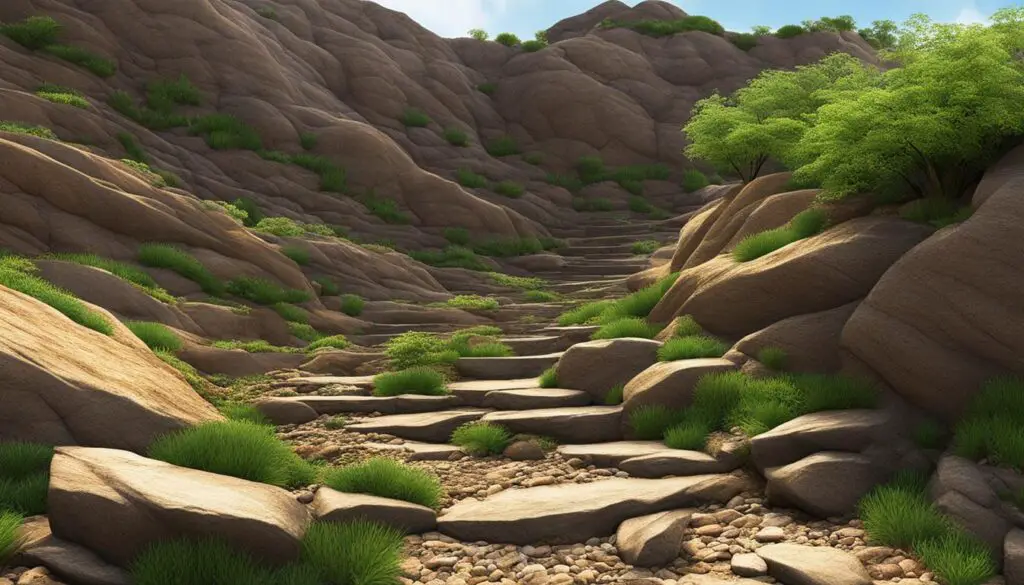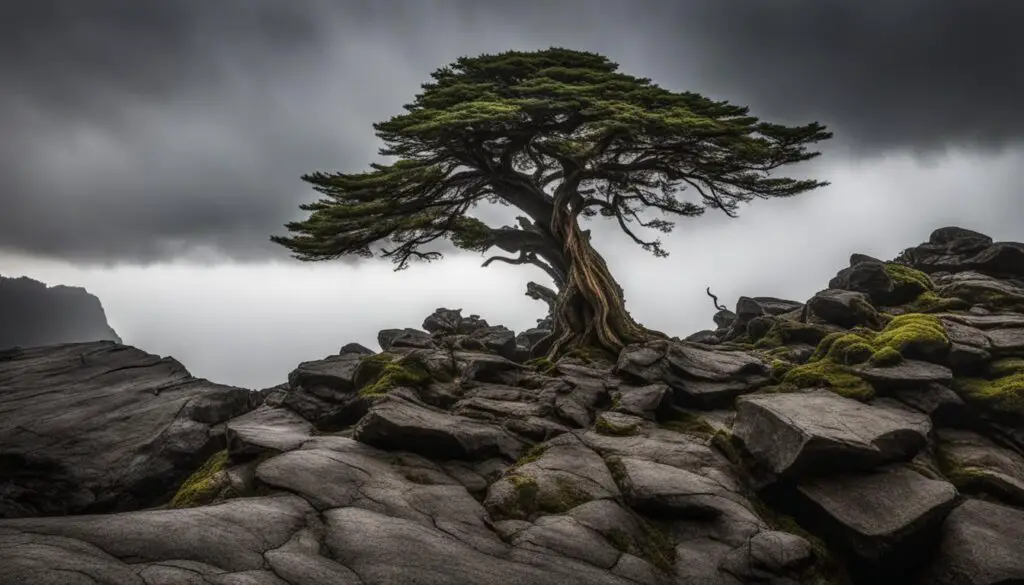Trees are magnificent living organisms that contribute to the beauty and balance of our ecosystem. Understanding the process of tree growth and the factors that influence it allows us to appreciate their importance and nurture their development. In this article, we will delve into the fascinating world of tree growth, exploring the stages of their life cycle, the conditions required for their optimal growth, and the intricacies of their growth process.
Key Takeaways:
- Tree growth is influenced by various factors including environmental conditions, soil nutrients, water availability, temperature, and sunlight.
- The life cycle of a tree involves stages such as seed dispersal, root growth, tree maturation, and eventually death and decomposition.
- Trees exhibit different growth rates and timelines depending on their species and environmental conditions.
- Trees growing in challenging environments like rocky terrain and cliff-sides have unique adaptations and survival strategies.
- Understanding the growth and survival of trees enhances our appreciation for the resilience and interconnectedness of nature.
The Life Cycle of a Tree
Understanding the life cycle of a tree is key to appreciating its importance in our ecosystem. From seed dispersal to death and decomposition, a tree goes through several stages in its journey. It all begins with the dispersal of seeds, which can be carried by wind, water, or animals to new locations. Once a seed finds a suitable spot, it germinates and starts its growth process.
Root growth is a vital stage for a tree’s survival. As the root system develops, it ensures stability and provides access to water and nutrients in the soil. This allows the tree to establish a strong foundation and continue its upward growth. Over time, the seedling transforms into a mature tree, characterized by a deep taproot and a network of thick lateral roots.
Despite their resilience, trees can face premature death due to various external factors. Natural disasters like floods and fires, as well as human activities such as deforestation, can disrupt a tree’s life cycle. As a result, the tree undergoes decomposition, returning vital nutrients back to the soil and supporting the growth of future generations of trees.
Understanding the life cycle of a tree helps us appreciate the importance of tree conservation and the impact of environmental factors on their growth. By protecting and maintaining healthy ecosystems, we can ensure the survival and growth of trees for generations to come.
The Stages of a Tree’s Life Cycle
- Seed dispersal: Seeds are spread through various means, including wind, water, and animals.
- Germination and root growth: Seeds find suitable conditions for growth, germinate, and develop a root system.
- Tree maturation: The seedling grows into a mature tree with a deep taproot and thick lateral roots.
- Tree death and decomposition: External factors, such as natural disasters or human activities, can lead to the premature death of a tree, followed by the decomposition process.
Understanding the life cycle of a tree provides insights into the intricacies of nature and the interdependence of living organisms. By protecting and preserving trees, we contribute to the well-being of our environment and ensure a sustainable future.
Factors Affecting Tree Growth
Tree growth is influenced by various factors, including environmental conditions, soil nutrients, water availability, temperature, sunlight, and tree species. These factors play a crucial role in determining the growth rate and overall health of trees. Understanding and optimizing these factors can have a significant impact on promoting healthy tree development.
Environmental conditions, such as the quality and composition of the soil, are essential for tree growth. Soil nutrients provide the necessary elements for tree nutrition and growth. The availability of water is another critical factor, as trees require an adequate water supply to support their physiological processes and prevent drought stress. Temperature also plays a role, as trees have specific temperature ranges in which they can thrive.
Sunlight is vital for photosynthesis, the process by which trees convert sunlight into energy. Different tree species have varying requirements for sunlight. Some trees thrive in full sun, while others prefer partial shade. Understanding the light requirements of different tree species is essential for planting them in suitable locations.
Furthermore, individual tree species have specific adaptations and requirements. Some trees are better suited for certain environmental conditions, while others may struggle to survive. By considering the specific needs of tree species, we can create optimal growth conditions and ensure their long-term health and vitality.
The Growth Process of Trees
Trees have a fascinating growth process that involves the development of roots, stems, and leaves. Understanding this growth process can help us appreciate the complexity and resilience of these incredible organisms. Let’s take a closer look at how trees grow.
Root Growth
Root growth is a crucial part of a tree’s development. Roots anchor the tree in the soil and serve as a means of absorbing water and nutrients. They also provide stability and support to the above-ground portion of the tree. As the tree grows, its root system expands and branches out, reaching deeper into the soil for more resources.
Stem Growth
Stem growth is responsible for the structural support of a tree. As the stem grows, it becomes thicker and stronger, enabling the tree to withstand external forces like wind and snow. The stem also acts as a transportation system, allowing water, sugar, and nutrients to move between the roots and the leaves. This flow is essential for the tree’s growth and overall health.
Leaf Development
Leaf development is a vital process in a tree’s growth. Leaves are responsible for photosynthesis, the process by which trees convert sunlight into food. Leaf development involves the production of new cells through specialized structures called meristems. These meristems continually produce new cells that allow for leaf growth and expansion. As the leaves grow, they provide the tree with the energy it needs to continue growing and thriving.

In summary, the growth process of trees involves root growth, stem growth, and leaf development. These interconnected processes work together to support the overall growth and survival of the tree. Understanding how trees grow can deepen our appreciation for nature’s remarkable design and inspire us to protect and conserve these magnificent organisms.
Tree Growth Rate and Timeline
Trees, like all living organisms, have their own unique growth rate and timeline. The rate at which a tree grows can vary depending on factors such as species, environmental conditions, and availability of resources. Some trees experience rapid growth spurts during favorable conditions, while others grow at a slower and more steady pace.
The timeline of tree growth can span several years or even centuries. It is important to note that trees have dormant periods where growth is minimal or even halted. These periods allow the tree to conserve energy and resources, especially during harsh weather conditions or unfavorable seasons.
Understanding the growth rate and timeline of trees is essential in studying their development and making informed decisions about planting and managing tree populations. By monitoring the growth rate and timeline, arborists and researchers can assess the health and age of trees, identify growth patterns, and implement appropriate care and maintenance strategies.
Environmental Adaptations of Trees on Rocky Terrain
Trees growing on rocky terrain, also known as rock trees, have fascinating adaptations that enable them to thrive in harsh and inhospitable environments. These trees have evolved unique root adaptations and survival strategies to overcome the challenges of rocky substrates and ensure their continued growth and survival.
One remarkable group of rock trees is known as lithophytes, which can grow directly in or on rocks. These trees have specialized root systems that penetrate crevices and cracks to access water and nutrients from the rocks themselves. They rely on the minerals present in the rocky substrate and have developed efficient mechanisms to extract and utilize them for their growth.
Another type of adaptation seen in rock trees is observed in epiphytes. These trees grow on other plants, using them as support structures, rather than rooting in the ground. Epiphytes have developed adaptations such as aerial roots or specialized root systems that allow them to attach to the host plants securely. This unique adaptation enables them to find suitable growing conditions even on rocky surfaces.
Root Adaptations and Survival Strategies
- Lithophytes have specialized root systems that penetrate rocks to access water and nutrients.
- Epiphytes grow on other plants, using them as support structures instead of rooting in the ground.
- Rock trees have evolved unique adaptations to overcome the challenges of rocky substrates.
These trees showcase the remarkable resilience and adaptability of nature, demonstrating how life can thrive in the most challenging environments.
In conclusion,
Trees on rocky terrain have evolved fascinating root adaptations and survival strategies to make the most of their challenging environment. Whether they are lithophytes growing directly on rocks or epiphytes relying on other plants for support, these trees have found innovative ways to thrive and survive. Their ability to extract nutrients from rocky substrates and make use of limited resources highlights the incredible adaptability and resilience of nature.
Survival Strategies of Cliff-side and Alpine Trees
Cliff-side and alpine trees demonstrate remarkable resilience and have evolved unique survival strategies to thrive in extreme environments. These trees face challenges such as strong winds, steep slopes, and poor soil quality, yet they have adapted in fascinating ways to ensure their survival.
One of the key strategies employed by these trees is the development of flexible branches. These branches have the ability to sway with the wind, reducing the risk of breakage and damage. By allowing their branches to move, cliff-side and alpine trees are able to withstand the powerful forces exerted by wind and maintain their structural integrity.
In addition to flexible branches, these trees also exhibit compact shapes that help them cope with heavy snowfall. The compact shape of their crowns prevents the accumulation of snow, minimizing the burden on the branches and reducing the risk of breakage. This adaptation allows these trees to thrive in alpine regions where snowfall is common.

Wind Resistance and Snow Adaptation
One of the most impressive survival strategies of cliff-side and alpine trees is their ability to withstand strong winds. The flexible branches and trunks of these trees allow them to bend and flex, reducing the impact of wind and preventing damage. This unique adaptation ensures that these trees can thrive in exposed cliff-side and alpine environments.
Moreover, these trees have also developed adaptations to survive in regions with heavy snowfall. Their compact shapes prevent the accumulation of snow on their branches, reducing the risk of breakage. Additionally, some alpine trees have needle-like leaves that provide efficient shedding of snow, ensuring their branches can withstand the weight and pressure.
Overall, cliff-side and alpine trees exemplify nature’s resilience and adaptability. Their flexible branches, compact shapes, and wind resistance strategies enable them to thrive in challenging environments. Understanding these survival strategies not only deepens our appreciation for these remarkable trees but also highlights the importance of preserving their habitats.
Water Retention and Survival Strategies of Rock Trees
Rock trees, also known as lithophytes, have developed remarkable survival strategies to thrive in dry conditions. These trees have adapted to retain water and endure periods of drought, showcasing their resilience in inhospitable environments.
One key survival strategy of rock trees is their ability to store water. They have evolved deep root systems that can access water sources deep within the ground, allowing them to sustain themselves during dry spells. By storing water in their leaves and stems, these trees can conserve moisture and survive prolonged periods of limited rainfall.
Another adaptation of rock trees is the presence of a waxy leaf coating. This coating reduces water loss through transpiration, helping the trees retain moisture in arid conditions. The waxy coating acts as a protective barrier, preventing excessive evaporation and allowing the trees to thrive in dry climates.
Through their deep root systems and waxy leaf coatings, rock trees have developed effective strategies to retain water and survive in dry environments. These adaptations showcase the incredible resilience of nature and the ability of trees to thrive under challenging conditions.
Key Points:
- Rock trees have adapted to retain water and survive in dry conditions.
- They store water in their leaves, stems, and deep root systems.
- A waxy leaf coating reduces water loss through transpiration.
- These survival strategies enable rock trees to thrive in arid environments.
Rock trees have developed remarkable survival strategies to retain water and endure in dry conditions. Their deep root systems allow them to access water sources deep within the ground, while their waxy leaf coating reduces water loss through transpiration. These adaptations enable rock trees to thrive in arid environments and showcase the incredible resilience of nature.
Plant Colonization on Scree Slopes
Scree slopes provide a unique ecological niche for plant colonization, as plants find a way to thrive on these rocky slopes despite the challenging conditions. These slopes, characterized by loose rocks and unstable substrate, seem inhospitable, yet they are home to a variety of plant species that have adapted to this environment.
Plants on rocky slopes have developed remarkable survival strategies to conquer the harsh conditions. Their root systems play a crucial role in anchoring themselves to the rocky substrate and preventing soil erosion. By forming intricate networks of roots, these plants stabilize the soil and prevent it from being washed away by rainfall or wind.
The ecological niche of scree slopes is also a result of the unique microclimatic conditions they offer. The loose rocks create air pockets that help insulate the plants’ roots, protecting them from extreme temperatures and allowing them to survive in both hot and cold climates. Furthermore, the rocky surface reflects sunlight, creating a microhabitat that may provide ideal conditions for certain plant species.
Soil erosion prevention: A vital role of plant colonization
“The plants that colonize scree slopes are the unsung heroes of soil erosion prevention. Their ability to anchor themselves to the rocky substrate and stabilize the soil is essential for maintaining the integrity of slopes and preventing sediment runoff.”
By colonizing scree slopes, plants not only adapt to their environment but also play a vital role in maintaining ecosystem balance. Their presence prevents soil erosion, reduces the risk of landslides, and provides habitat for a diverse array of organisms. Additionally, the plants’ roots trap sediment and organic matter, which enriches the soil over time, paving the way for further colonization and ecosystem development.
In conclusion, the colonization of scree slopes by plants is a testament to the resilience and adaptability of nature. Despite the challenging conditions, plants have found innovative ways to anchor themselves, stabilize the soil, and create a thriving ecosystem. Understanding the process of plant colonization on scree slopes not only helps us appreciate the tenacity of nature but also underscores the importance of preserving these fragile environments.

Weathering and Rock Substrate in Tree Survival
Weathering and the composition of rock substrate are significant factors that influence tree growth and survival. As rocks break down through weathering processes, they release essential nutrients into the soil, providing nourishment for trees. This nutrient availability plays a crucial role in supporting tree growth and overall health.
Furthermore, different types of rock substrate have varying compositions that can directly impact tree survival. Rocks such as limestone and basalt, for example, are rich in minerals and provide fertile ground for tree roots to penetrate and absorb necessary nutrients. These favorable rock substrates contribute to the resilience and longevity of trees in their respective environments.

By understanding the relationship between weathering, rock substrate, and tree growth, we can better appreciate the interconnectedness of geological and biological processes. Trees rely on the availability of nutrients from weathered rocks to thrive, illustrating the remarkable adaptability and resourcefulness of these living organisms. This knowledge also highlights the importance of conserving natural landscapes and protecting the delicate balance of ecosystems to ensure the continued survival of trees and the many benefits they provide.
Mountain Vegetation and Ecological Niches
Mountain vegetation is a remarkable testament to the adaptability of trees in extreme conditions. These hardy plants have evolved various adaptations to survive low temperatures, strong winds, and poor soil conditions. Their ability to thrive in such challenging environments plays a crucial role in maintaining the delicate balance of mountain ecosystems.
One key adaptation of mountain trees is their ability to withstand low temperatures. These trees have developed specialized mechanisms to protect themselves from freezing temperatures, such as producing antifreeze proteins and reducing water loss through their leaves. These adaptations enable them to survive and continue their vital ecological roles, even in the harshest cold climates.
Strong winds are another significant challenge faced by mountain vegetation. Trees in these regions often have flexible branches and compact shapes to withstand the powerful gusts. By bending and swaying with the wind, they reduce the risk of breakage and maximize their chances of survival.
The poor soil quality commonly found in mountainous areas poses yet another obstacle for tree growth. However, mountain vegetation has adapted by developing efficient root systems that can extract nutrients from the limited resources available. These trees play a crucial role in preventing soil erosion and stabilizing the mountain slopes, ensuring the long-term health and functionality of the entire ecosystem.
Every Tree for Itself: Understanding Tree Survival
Trees, just like us humans, have unique mechanisms for survival. They require essential resources such as nutrients, air, water, and sunlight to thrive in their environment. Let’s take a closer look at how trees obtain and utilize these crucial elements to ensure their survival.
Tree Nutrients: Feeding the Green Giants
Trees need nutrients to grow and maintain their overall health. Through their root systems, trees absorb essential elements from the soil, such as nitrogen, phosphorus, and potassium. These nutrients are crucial for various functions, including energy production, defense against pests and diseases, and the development of strong and healthy tissues.
Tree Respiration: Breathing Life into the Canopy
Just like humans, trees need to breathe to survive. Through tiny pores on their leaves called stomata, trees take in carbon dioxide from the air. This carbon dioxide is then converted into oxygen through a process called photosynthesis. Oxygen is vital not only for the tree’s own respiration but also for the surrounding environment, as it supports the respiratory needs of other organisms.
Tree Drinking and Eating: Watering and Nourishing the Giants
Water is essential for tree survival, and trees have remarkable strategies to acquire it. Through their extensive root systems, trees absorb water from the soil, transporting it up to their leaves. Additionally, trees also absorb water through their leaves during periods of high humidity. Along with water, trees obtain nutrients from the soil and use them to produce food through photosynthesis. This process allows trees to convert sunlight, water, and carbon dioxide into glucose, which serves as their primary source of energy.
Tree Breathing: Exchanging Gases with the Environment
Similar to humans, trees exchange gases with the environment. Through the process of transpiration, trees release water vapor into the air through their leaves. This not only helps to cool the tree and regulate its temperature but also contributes to the moisture in the surrounding atmosphere. Additionally, trees release oxygen into the air as a byproduct of photosynthesis, enriching the environment with this vital element.
Understanding the intricacies of tree survival allows us to appreciate the incredible adaptations and interconnectedness of the natural world. By safeguarding the resources that trees need to thrive, we can ensure the continued existence of these magnificent organisms and the vital role they play in our ecosystems.
FAQ
How do trees grow?
Trees grow through a process that involves seed dispersal, germination, root and stem growth, leaf development, and maturation. Understanding this process helps us appreciate their beauty and importance.
What factors affect tree growth?
Several factors influence tree growth, including environmental conditions such as soil nutrients, water availability, temperature, and sunlight. Each tree species also has specific requirements and adaptations to different conditions.
What are the stages of a tree’s life cycle?
A tree’s life cycle starts with seed dispersal and continues with germination, root and stem growth, leaf development, and maturation. Eventually, a tree may face external stressors or reach the end of its life, leading to death and decomposition.
How long does it take for a tree to grow?
The growth rate and timeline of trees vary depending on the species and environmental conditions. Some trees experience rapid growth spurts, while others grow slowly over an extended period. The timeline of tree growth can span several years or even centuries.
How do trees survive on rocky terrain?
Trees on rocky terrain, known as rock trees, have unique adaptations that allow them to survive in harsh environments. Some extract nutrients from rocks, while others grow on other plants for support. These trees have developed special root adaptations to anchor themselves and find water and nutrients.
How do trees survive in extreme conditions like cliffs and alpine regions?
Trees in cliff-side and alpine regions have evolved survival strategies to thrive in challenging environments. They often have flexible branches that sway with the wind, reducing the risk of breakage. Alpine trees also have compact shapes that prevent snow accumulation and minimize damage from heavy snowfall.
How do trees retain water and survive in dry conditions?
Trees growing in dry conditions, like rock trees, have developed survival strategies to endure periods of drought. They store water in their leaves, stems, and deep root systems. Some even have a waxy coating on their leaves that reduces water loss.
What is the importance of plant colonization on scree slopes?
Plant colonization on scree slopes plays a crucial role in preventing soil erosion. Trees and other plants that grow on rocky slopes have adapted to the unstable substrate and help maintain the balance of ecosystems.
How does weathering and rock substrate affect tree survival?
Weathering, the process of rock breakdown, contributes to the availability of nutrients necessary for tree growth and survival. Certain types of rock substrates provide favorable conditions for tree growth due to their composition and nutrient release.
How do trees survive in mountainous regions?
Trees in mountainous regions have adapted to low temperatures, strong winds, and poor soil quality. They play a vital role in preventing soil erosion, providing habitat for wildlife, and enhancing the overall beauty of mountain landscapes.
What are the basic needs of trees for survival?
Trees, like humans, need nutrients, air, water, and sunlight to survive. They obtain these resources through their roots, trunks, and leaves, allowing them to thrive and contribute to the ecosystem.

